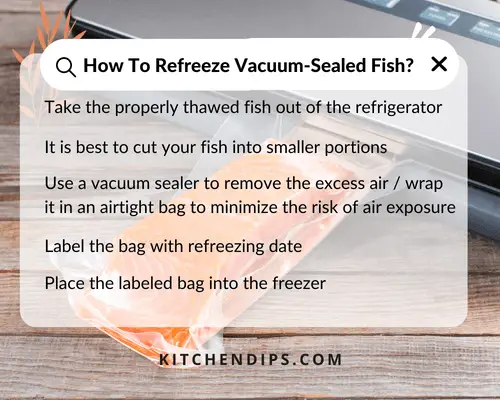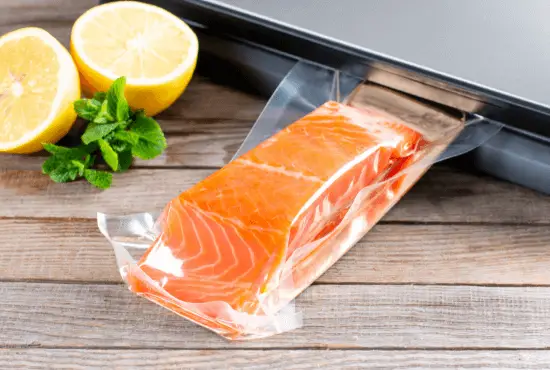As fish is rich in protein and contains little cholesterol, you might store it in a vacuum-sealed bag to never run short of it. But, even after observing all the safety steps and tips, you might still be reluctant to freeze it again after thawing and wondering if can you refreeze vacuum-sealed fish.
You can refreeze cooked or uncooked, vacuum-sealed fish that thaws in the refrigerator. Avoid thawing fish by other methods if you plan to refreeze it. Fish is an easy target for microbes and can make the meat rancid so it is important not to leave it at room temperature for long.
Vacuum-sealing food is a game-changer and enables you to maintain its freshness. But, refreezing is a complicated procedure. You need to perform it according to the instructions highlighted in this article for your ease.
Table of Contents
Is It Safe To Refreeze Vacuum-Sealed Fish?
It is perfectly safe to refreeze vacuum-sealed fish if you thaw it in the refrigerator and cover it in high-quality freezer bags. If the packaging is not up to the mark, fish might develop freezer burns and deteriorate inside the freezer.
Vacuum sealing is one such effective way that allows you to keep the fish fresh in the freezer for as long as two years. As all the air gets removed from the bag, no bacteria can grow, and there will be no freezer burn. So, you might prefer vacuum-sealing fish before freezing it.
This rule applies to both raw and cooked fish, but you might notice some degradation in the overall quality. It is due to the loss of moisture that happens when you thaw the fish frequently. However, if it sits out of the refrigerator for more than two hours, you can no longer refreeze it.
Seafood tends to perish quickly and thus requires proper storage to make them shelf-lasting. There is a high chance that the fish can get contaminated if exposed to open air for too long. Thus, even refreezing won’t be enough to reverse the spoilage and prevent the spread of the bacteria. Thus, it is better to discard the leftovers as they might cause stomach-related diseases.
Can You Refreeze Fish Vacuum-Sealed At Home?
You can perfectly refreeze vacuum-sealed fish at home if you thaw it in the refrigerator and cover it in high-quality freezer bags. If the packaging is not up to the mark, fish might develop freezer burns and deteriorate inside the freezer.
Vacuum sealing keeps the fish texture intact, and it refreezes again without losing much of its quality and taste. It has minimal chances of a bacteria buildup and is all set to go for another round of freezing.
But, it is necessary to thaw the vacuum-sealed fish in the refrigerator and not by other techniques. For instance, if you let it defrost on the countertop, it can get contaminated and, as a result, no more suitable for refreezing.
Similarly, microwaving the fish and then freezing it later will be of no use as it is already on the verge of spoilage.
In the case of cooked fish, you can refreeze after cooling it down first. The abrupt temperature change is a precursor to freezer burns, so it is crucial to let it reach the right temperature before sticking it inside the freezer.
Can You Refreeze Store Vacuum-Packed Fish?
When the fish you purchase comes in vacuum packaging, you can successfully refreeze it. The packaging design can provide maximum support and keep it fresh and flavorful. So, if the seal is still intact and the fish slightly thaws, you can pop it inside the freezer without worrying about quality loss.
If you have opened the packaging, it is crucial to transfer the fish to the freezer as quickly as possible and not let it sit in the open air for an extended period. Also, wrap the packaging in a heavy-duty freezer bag so that the meat is secure and doesn’t come in contact with cold freezer air.
In case the fish thaws on the way back home, you can still refreeze it but avoid delaying the process too much. The more you keep it outside the freezer, the earlier it will start showing symptoms of spoilage like a sour smell or slimy texture.
How To Refreeze Vacuum-Sealed Fish?

Buying vacuum-sealed fish from the grocery store proves to be very beneficial as the packaging keeps the fish from drying out by preventing water loss.
Let’s see what steps you need to take for storing it again once you have the sealed fish.
- If you haven’t opened the packaging yet, you can place the fish directly into the freezer. Ensure to store it in a safe corner of the freezer to expose it to a consistent temperature.
- If the seal is open, wrap the meat in aluminum foil or high-quality plastic wrap. Fold all the edges securely to provide full coverage.
- For a large amount, wrap each fish separately instead of them together. It will prevent the meat from sticking with one another and allow you to thaw only the required amount.
- Now, transfer it to an airtight container. You can also go for Ziploc bags if you don’t possess airtight containers.
- Don’t squish the fish by piling up too many food items over it. The meat is tender and cannot withstand the extra load you put on it.
- Lastly, label the bag with the initial refreezing date of the fish and let it store for a few months.
Note: after thawing the vacuum-sealed fish, thoroughly check it for any traces of freezer burns that include discoloration and an off odor. And, if you notice any such changes, it is better to utilize the fish by chopping off the discolored sections.
How Long Is It Okay To Refreeze Vacuum Sealed Fish?
The shelf-life of a vacuum-sealed fish is generally longer than the ones you store in ordinary safety bags. When you thaw it properly, it can refreeze well if you are careful with the handling.
Sealed fish that you defrost in a refrigerator will refreeze for more than five months until the time to use. Once you thaw the fish, it can last in the fridge for a maximum of two days and not more.
You have to refreeze it within this time, or else it might be at risk of turning inedible. Cooked fish is good for up to three to four days, and the technique of your preparation will allow it to have a longer shelf life.
Defrosting your meat by other methods such as leaving it on the countertop or heating it in a microwave might not go with the refreezing process. The fish is prone to degrade faster at a high temperature, and thus freezing it again won’t stop it from spoilage. Similarly, letting the sealed fish be exposed to open air unchecked can make it unsafe for consumption.
How Many Times Can You Freeze A Vacuum-Sealed Fish?
Whether vacuum-sealed or not, you can refreeze fish only one time, provided that you followed all the safety guidelines for the initial freezing and thawing. Once you refreeze the fish, it can change its taste and texture even after covering it well.
It is because fish is made up of 70-84 percent water and the water expands during freezing. When you refreeze it more than once, it becomes mushy, and you might not want that.
Moreover, the freezer environment is harsh, and ice crystals may form on the surface of the fish. So, when you defrost it, the texture becomes unpleasant, and it might taste bland to you.



